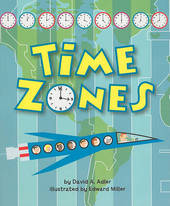
|
Time Zone
Paperback / softback
Main Details
| Title |
Time Zone
|
| Authors and Contributors |
By (author) David A Adler
|
|
Illustrated by Edward Miller III
|
| Physical Properties |
| Format:Paperback / softback | | Pages:31 | | Dimensions(mm): Height 249,Width 206 |
|
| ISBN/Barcode |
9780823423859
|
| Classifications | Dewey:389.17 |
|---|
| Audience | |
|---|
| Illustrations |
Maps; Line drawings, color; Illustrations, color
|
|
Publishing Details |
| Publisher |
Holiday House Inc
|
| Imprint |
Holiday House Inc
|
| Publication Date |
1 June 2011 |
| Publication Country |
United States
|
Description
What are time zones and why do they exist? When it's noon where you live, why is it midnight halfway around the world? This entertaining book explains why time zones exist and includes little-known facts and historical lore, an explanation of Daylight Savings Time, and a hands-on activity that can be performed at home or in the classroom.
Author Biography
David A. Adler is the celebrated author of more than two hundred books for children. His books have received many honors, including the Sydney Taylor Book Award, Boston Globe-Horn Book Award Honor Book, a Golden Kite Honor Book, and a NCTE Orbis Pictus Award Honor Book. He lives in the New York City metropolitan area. Edward Miller III is the author, illustrator, and designer of many nonfiction books, including The Tooth Book: A Guide to Healthy Teeth and Gum and The Monster Health Book, a Bank Street Best Children's Book of the Year that School Library Journal called "lively" and "visually appealing." Visit his website at www.edmiller.com.
ReviewsThe creators of Fun with Roman Numerals (2008) and Money Madness (2009) collaborate here to explain the concept of time zones. Miller employs an astronaut and his robot dog to serve as guides for Adler's discussion of the differences in times around the globe caused by the earth's rotation in an easterly direction, resulting in later times as one travels east. He notes the difficulties faced (particularly with train travel) before the 1883 adoption of standardized time, describes how the 24 zones are adjusted to accommodate heavily populated areas or a particular country's preferences, and clarifies the need for the prime meridian and international date line. Miller's bold, cartoon-style collage art invites readers to ponder the ideas Adler presents. His use of humorous characters (a smiling sun and several Martians) adds to the book's appeal without detracting from the science. Numerous maps, diagrams, and a few documentary photos also help to clarify complex ideas, and a globe and lamp demonstration will help students visualize time zones. -- Kay Weisman
|